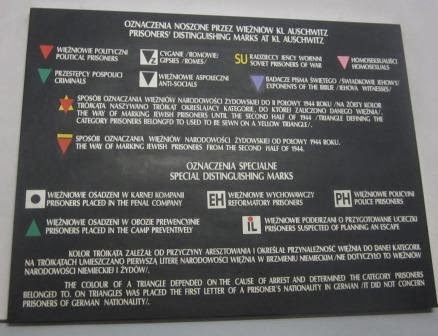 There are many phrases or names from concentration camps known better in German, as they were known then, rather than if they are referred to in their English names. Henry spoke of them in German, history books speak of them in German, and thus I will refer to them in German, with explanations.
There are many phrases or names from concentration camps known better in German, as they were known then, rather than if they are referred to in their English names. Henry spoke of them in German, history books speak of them in German, and thus I will refer to them in German, with explanations.
The German names are in fact universally recognized – since every nationality there knew who a ‘Capo’ was, what it meant to stand in a long appell(roll call), the role of ‘colors’ (prisoners identified by different color triangles – which Henry always called ‘winkels’) and that the head of the camp was the Commandant (or Kommandant.)
Rudolf Höss (pronounced ‘Hess’), the first commandant of Auschwitz, began his work in concentration camps in 1934 in Dachau, and was promoted to Sachsenhausen in 1938. When charged with starting Auschwitz, he reused the saying ‘Arbeit Macht Frei’ from the gates of Dachau, and from Sachsenhausen he brought SS Sergeant Gerhard Palitzsch with him. Palitzsch (more on him later) chose thirty criminals from Sachsenhausen to come to Auschwitz as ‘Capos.’ In Jewish sections there were ‘Capos’ appointed over other Jews as well. (Henry explained to me that ‘Capo’ came from the Italian word for head – chief – boss, though why Germans chose an Italian reference is beyond me.)
These 30 Capo’s, though officially under SS supervision, ran (or terrorized) the various blocks in the camp. Even now, Henry knows these people as Capo Jakob, Capo Bruno, Capo Arno, etc. When I was at the Aushwitz museum and asked about ‘Bloody Michael’ – they immediately recognized the reference as ‘Bloody Mietek.’ Though Capos were still prisoners themselves, they held the most important jobs, ran the day to day lives of prisoners, and were to be highly feared. So in reality – the people the Nazis charged with running Auschwitz on a daily basis – were all convicted criminals.
The town of Oświęcim in Poland was selected for several reasons – it was ‘off the beaten track in the backwoods of Poland.’ In fact Höss soon cleared out over 70 square miles by evicting Polish families. He used an abandoned Polish army camp with existing buildings. There was accessibility to water and to rail lines. Like every other city the Germans claimed in Poland, they renamed towns from Polish to German – thus ‘Auschwitz’ was the new German name.
A word about colors. The Germans came up with a quick and visual classification of prisoners in all the camps – colored triangles worn on prisoner uniforms. Red for political, Green for criminal, Black for ‘anti-socials’ and gypsies, Pink for homosexuals, Purple for Jehovah’s Witness, and the letters ‘SU’ in yellow for Soviet POWs, with a few other variations.
As an analogy, if you think of how current prison populations are split along racial lines – e.g. Blacks, Whites, Latinos and Asians, camp prisoners were grouped and known by colors, primarily the reds, blacks and greens. The colors competed for power. In some camps either the ‘Reds’ were more in charge and were generally more orderly and less violent (Buchenwald;) or the ‘Greens’ (e.g. the criminals) were delegated more authority. In Auschwitz – greens were in charge.
Source: Hoss, Rudolf, Memoirs of the SS Kommandant at Auschwitz; Auschwitz Birkenau Guide-book, Auschwitz-Birkenau State Museum in Oświęcim.
Photo – taken at Auschwitz Museum in October 2013 – while a bit small to read it was a summary of the triangle colors.
